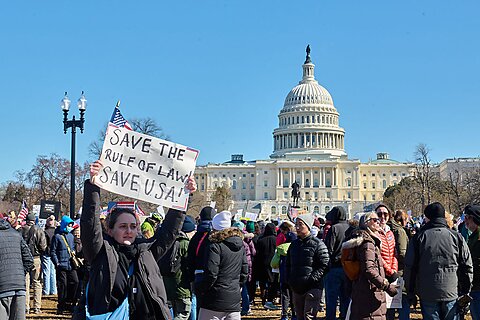On Trump’s Anti-Antifa Executive Order

On September 22, Trump issued his long-threatened executive order (EO) designating an idea—antifascism, known by its shorthand version, Antifa—a “domestic terrorist organization.”
Yes, on the surface, the EO is idiotic on multiple levels. The notion that an idea can be designated an organization is one. The fact that there’s no constitutional provision or statute granting any president the power to designate a domestic civil society organization a “domestic terrorist organization” is another.
The EO’s declaration that “Antifa is a militarist, anarchist enterprise that explicitly calls for the overthrow of the United States Government, law enforcement authorities, and our system of law” is more than false—it is designed to act as a justification for legal and coercive action against anyone or any entity that the regime designates as engaged in
… efforts to obstruct enforcement of Federal laws through armed standoffs with law enforcement, organized riots, violent assaults on Immigration and Customs Enforcement and other law enforcement officers, and routine doxing of and other threats against political figures and activists.
I’m only aware of one anti-ICE raid incident in California over the summer in which a single agitator pointed a pistol at federal agents, and that person is apparently still at large. That’s not the “organized riot” the regime has claimed, and they’ve produced no evidence that the individual is connected to any group calling for the overthrow of the federal government.
And none of those things matter, contrary to a lot of the legal or political commentary you may have already seen. What matters is that the administration asserts the authority to do this, and it has thousands of armed and armored federal law enforcement agents ready and able to carry out Trump’s orders—just as ICE and other federal agents (including mobilized National Guard troops) have been carrying out “immigration enforcement” operations of dubious or no legality for months.
What’s also important to remember is that for decades, the FBI has had and continues to maintain specific investigative categories designated “Terrorism Enterprise Investigation” and “Act of Terrorism—Domestic Terrorism” (AOT-DT) that target multiple categories of groups, as the screenshots below from the FBI’s Classification List (obtained by Cato via the Freedom of Information Act (FOIA)) show:
It is the Classification 266 type investigations that will most likely be used to target individuals tagged as “Antifa” or “Antifa associated,” and the Classification 100 AOT-DT type investigations that will be used to go after self-identified or otherwise tagged by the FBI as “Antifa” or “Antifa associated.”
In the summer of 2018, the Oregon State Police and the FBI’s Portland Field Office conducted a joint investigation targeting Rose City Antifa, although it’s unclear whether that investigation was closed or remains ongoing. What is clear is that the organization remains active and vehemently opposed to Trump and his policies, making it and its members a likely target under the president’s new EO.
And the FBI is not the only federal law enforcement agency that tracks groups associated with the larger Antifa movement.
In May 2022, Cato filed a FOIA lawsuit against the Secret Service seeking records on anarchist, Antifa, and other political groups on the political left to determine the level of Secret Service monitoring of such groups and whether any of it violated the First or Fourth Amendment rights of the members of those groups. Cato prevailed in the litigation, securing the release of nearly 700 pages (WARNING: large file) of heavily redacted but relevant Secret Service records that mentioned such groups and their activities. This extract from the litigation shows that the Secret Service investigation was categorized as “Antifa Movement Nationwide” and was active at least as late as March 2022—during the Biden administration:
If you peruse the unredacted and readable portions of the records Cato obtained, you’ll find multiple groups listed with “Antifa” in their titles. You’ll also notice that the Secret Service tended to lump anarchists and Antifa elements under a single umbrella. While there’s certainly overlap between such self-identified groups, there are also philosophical and other differences—but none of that nuance is generally a concern for federal law enforcement agencies, and it’s apparently not a concern for Trump. In his worldview, they apparently are all violent radicals opposed to him and his policies, which is why they have now been officially elevated to “Enemy of the Regime” status via his EO.
George Orwell, one of the most well-known antifascists of the last century, is undoubtedly rolling over in his grave right now.





